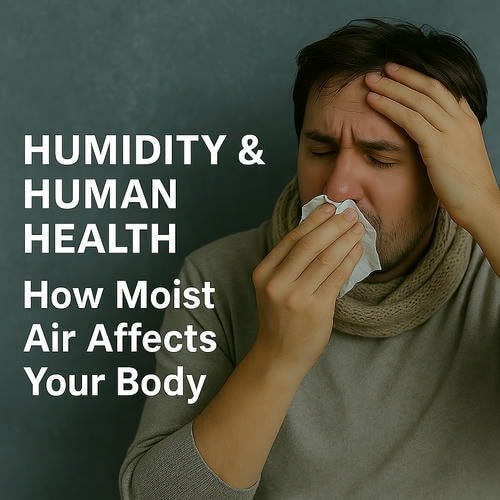Humidity, the amount of moisture in the air, plays a crucial role in how our bodies feel and function. While most of us notice humidity mainly as discomfort—sticky skin, frizzy hair, or that heavy, oppressive feeling—its effects go far deeper, influencing our respiratory health, immune system, heart function, and overall well-being. Understanding how humidity impacts the human body can help us better manage its effects, especially as climate change causes more extreme weather patterns with fluctuating humidity levels.
What Is Humidity and Why Does It Matter?
Humidity refers to the concentration of water vapor in the air, often expressed as relative humidity (RH), which is the percentage of moisture in the air relative to the maximum it can hold at a given temperature. The ideal indoor RH for human health is generally between 40% and 60%. Levels outside this range—either too low or too high—can trigger health problems.
How Humidity Affects Your Body
1. Respiratory System and Breathing
Humidity directly impacts the respiratory tract. When humidity is too low (below 30-40%), the air dries out the mucous membranes lining your nose and throat, making them more vulnerable to irritation, infections, and allergies. This dryness can worsen symptoms for people with asthma or allergies by impairing the natural barrier function of the mucosa.
Conversely, high humidity (above 60-70%) creates an environment conducive to the growth of mold, dust mites, and other allergens. This worsens asthma and allergy symptoms by increasing exposure to these irritants. High humidity also thickens mucus, making it harder to clear from the lungs, which can increase the risk of respiratory infections.
2. Immune System and Infection Risk
Humidity influences how viruses and bacteria survive in the air. Studies show that both very low and very high humidity levels can increase the growth and stability of pathogens. For example, influenza viruses thrive in dry air (below 40% RH), while bacteria and fungi proliferate in moist environments (above 60% RH). This means that improper humidity can lead to a higher risk of infections, especially indoors.
3. Skin and Eye Health
Low humidity causes the skin to lose moisture, leading to dryness, irritation, and exacerbation of conditions like eczema. Similarly, dry air affects the eyes by reducing the tear film, causing discomfort and dryness. On the other hand, high humidity can promote sweating and skin infections, and may also cause skin to feel sticky or clammy.
4. Body Temperature Regulation
One of the most significant effects of high humidity is on the body’s ability to cool itself. Normally, sweating helps dissipate heat through evaporation. However, when the air is saturated with moisture, sweat does not evaporate efficiently. This slows down the body’s cooling mechanism, causing internal body temperature to rise, which can lead to heat exhaustion or heat stroke.
This impaired cooling can cause symptoms such as fatigue, muscle cramps, headaches, nausea, dizziness, and in severe cases, can be fatal. The body may feel hotter than the actual temperature, increasing discomfort and health risks during hot and humid weather.
5. Cardiovascular Stress
High humidity places additional strain on the heart. The heart must pump harder to circulate blood and help regulate body temperature. This increased workload can be dangerous for people with heart disease or high blood pressure, potentially triggering arrhythmias, heart attacks, or heart failure.
Who Is Most Vulnerable?
Certain groups are more susceptible to the adverse effects of humidity:
- People with respiratory conditions such as asthma and COPD experience worsened symptoms due to airway constriction and allergen proliferation in humid air.
- Individuals with cardiovascular diseases face increased risks because their hearts work harder in hot, humid conditions
- People with diabetes may experience dehydration faster and have difficulty regulating body temperature
- Those with allergies are affected by increased mold and pollen growth in humid environments
- Older adults and young children are generally more vulnerable to heat-related illnesses caused by high humidity
Managing Humidity for Better Health
Maintaining indoor humidity between 40% and 60% is ideal for comfort and health. Here are some practical tips:
- Use dehumidifiers and air conditioners during hot, humid months to reduce indoor moisture and improve air quality
- Use humidifiers in dry seasons or climates to prevent dryness-related irritation
- Ventilate your home regularly to prevent mold growth and reduce allergens.
- Stay hydrated and avoid strenuous outdoor activity during extreme heat and high humidity.
- Wear breathable, lightweight clothing to help sweat evaporate more efficiently.
- Monitor indoor humidity with a hygrometer to keep levels in the optimal range.
Conclusion
Humidity is more than just a discomfort factor; it significantly affects how our bodies function. Both excessively high and low humidity levels can impair respiratory health, weaken immune defenses, cause skin and eye irritation, and challenge the body’s ability to regulate temperature. Understanding these effects helps us take steps to protect ourselves, especially vulnerable populations, during extreme weather conditions. By managing indoor humidity and staying aware of how moist air affects our bodies, we can maintain better health and comfort year-round.
This overview highlights how important it is to pay attention to humidity—not just temperature—when considering our health and well-being.



